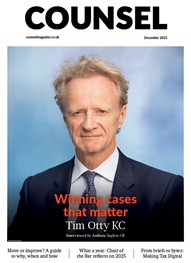*/
Two of the most senior judges expressed concern at the lack of diversity among judges.
‘Despite the leadership that has been demonstrated over the last year, progress is not as fast as we would wish,’ the Lord Chief Justice, Lord Thomas, and the Senior President of Tribunals, Sir Ernest Ryder, said in a statement accompanying the annual statistics for the make-up of the bench.
The figures showed that from April 2014 to April 2017, the percentage of female judges has increased from 18% to 24% in the Court of Appeal; 18% to 22% in the High Court and 24% to 28% in the courts judiciary.
While the percentage of black and minority ethnic (BAME) judges had increased from 6% to 7%, the judges said it was ‘disappointing’ that the percentage of non-barristers dropped from 37% to 34%.
In tribunals in the last four years the proportion of female judges rose from 43% to 45%, and the percentage of BAME judges increased from 9% to 10%, but the proportion of judges with a non-barrister background fell from 67% to 66% between 2015 and 2017.
The two senior judges said: ‘We remain very concerned about the slow recruitment of BAME judges and the downward trend of new non-barrister (solicitors and legal executives) judges, despite the dedicated work undertaken by the Judicial Diversity Committee.’
Two of the most senior judges expressed concern at the lack of diversity among judges.
‘Despite the leadership that has been demonstrated over the last year, progress is not as fast as we would wish,’ the Lord Chief Justice, Lord Thomas, and the Senior President of Tribunals, Sir Ernest Ryder, said in a statement accompanying the annual statistics for the make-up of the bench.
The figures showed that from April 2014 to April 2017, the percentage of female judges has increased from 18% to 24% in the Court of Appeal; 18% to 22% in the High Court and 24% to 28% in the courts judiciary.
While the percentage of black and minority ethnic (BAME) judges had increased from 6% to 7%, the judges said it was ‘disappointing’ that the percentage of non-barristers dropped from 37% to 34%.
In tribunals in the last four years the proportion of female judges rose from 43% to 45%, and the percentage of BAME judges increased from 9% to 10%, but the proportion of judges with a non-barrister background fell from 67% to 66% between 2015 and 2017.
The two senior judges said: ‘We remain very concerned about the slow recruitment of BAME judges and the downward trend of new non-barrister (solicitors and legal executives) judges, despite the dedicated work undertaken by the Judicial Diversity Committee.’


Chair of the Bar reflects on 2025
Q&A with criminal barrister Nick Murphy, who moved to New Park Court Chambers on the North Eastern Circuit in search of a better work-life balance
Revolt Cycling in Holborn, London’s first sustainable fitness studio, invites barristers to join the revolution – turning pedal power into clean energy
Rachel Davenport, Co-founder and Director at AlphaBiolabs, reflects on how the company’s Giving Back ethos continues to make a difference to communities across the UK
By Marie Law, Director of Toxicology at AlphaBiolabs
AlphaBiolabs has made a £500 donation to Sean’s Place, a men’s mental health charity based in Sefton, as part of its ongoing Giving Back initiative
Little has changed since Burns v Burns . Cohabiting couples deserve better than to be left on the blasted heath with the existing witch’s brew for another four decades, argues Christopher Stirling
Six months of court observation at the Old Bailey: APPEAL’s Dr Nisha Waller and Tehreem Sultan report their findings on prosecution practices under joint enterprise
Despite its prevalence, autism spectrum disorder remains poorly understood in the criminal justice system. Does Alex Henry’s joint enterprise conviction expose the need to audit prisons? asks Dr Felicity Gerry KC
With automation now deeply embedded in the Department for Work Pensions, Alexander McColl and Alexa Thompson review what we know, what we don’t and avenues for legal challenge
Why were some Caribbean nations given such dramatically different constitutional frameworks when they gained independence from the UK? Dr Leonardo Raznovich examines the controversial savings clause